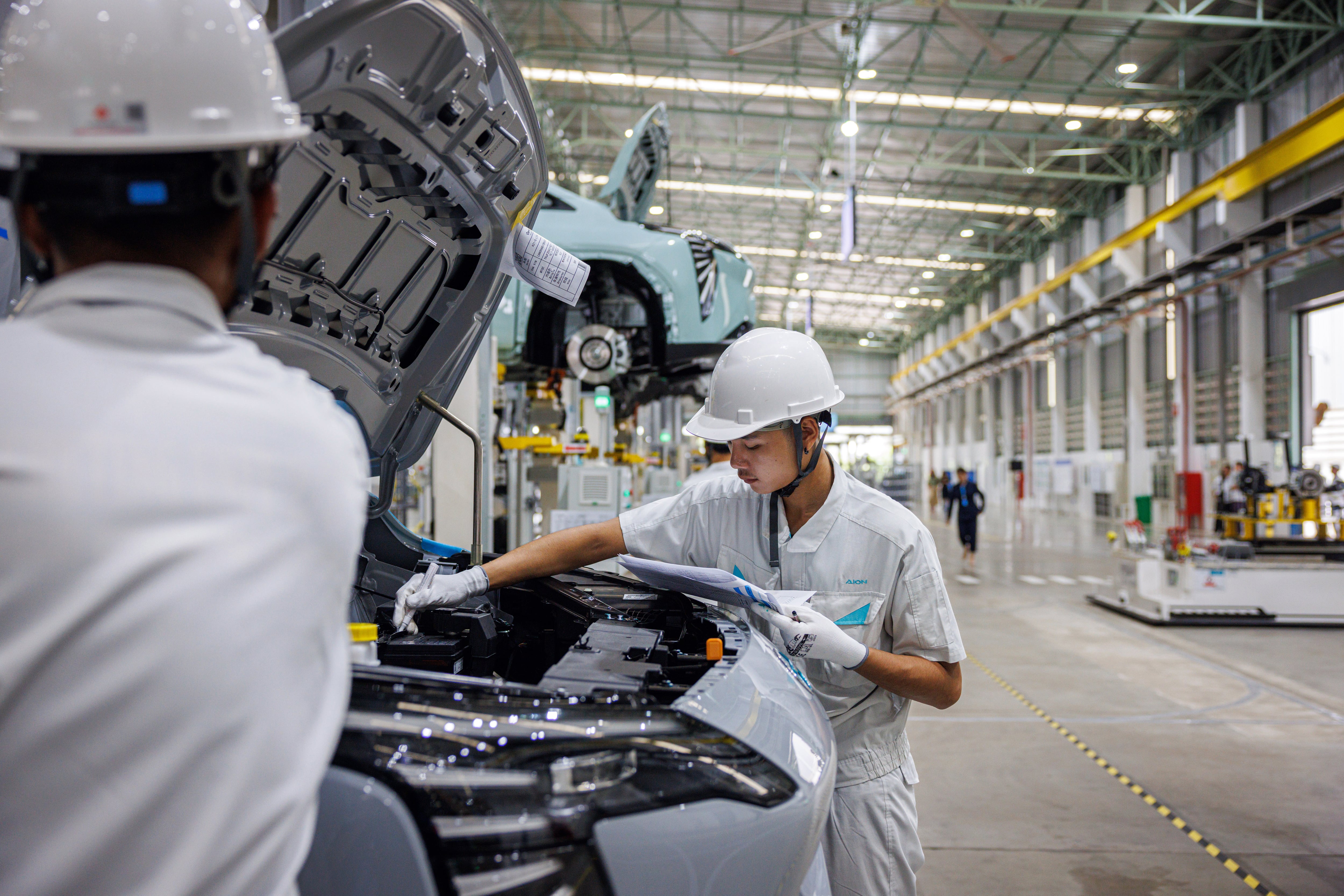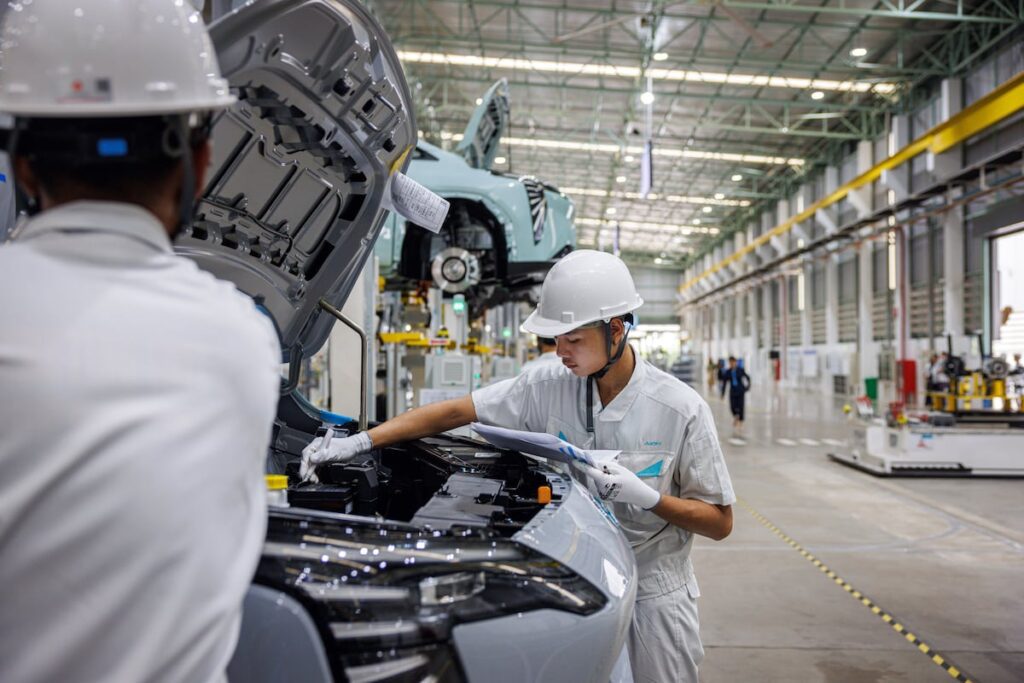
China has entered a new phase of global expansionism. Its technology companies — linked to the green transition — have begun to sow seeds in countless territories. Every so often, an agreement is announced to lay the groundwork for a production plant that will churn out electric vehicless, batteries, electrolyzers for the production of green hydrogen, or solar panels. This is happening across the world, including in Spain, Brazil, Germany, Vietnam, Mexico, Turkey and Hungary.The new trend speaks to the international vocation of Beijing, which seeks to lead a sector in which it sees itself as being one step ahead of its competitors, due to its technological capacity and productive power. It wants to reach all corners of the planet, so as to be close to key markets. This expansion — which has been underway for some time — accelerated after the pandemic. It’s part of the industrial bet made by the People’s Republic in the face of an economy hit by the bursting of a gigantic real estate bubble. If China’s internal demand doesn’t revive, it will have to go abroad to look for it.Foreign direct investment has also become the Asian giant’s response to get around the growing wall of trade restrictions against massive — and heavily subsidized — exports. This wall is being raised by the European Union, the United States and a handful of other countries concerned about China’s reach in these sectors. The appeal of Chinese companies expanding overseas has become both a negotiating tool for Beijing to try to reduce tariffs, as well as a weapon of geopolitical penetration with the potential to redesign the map of alliances. This is especially the case in the Global South.The new expansion promises to open another chapter in the saga of trade disputes with the West. And it could rise to the category of Trade War 2.0 if Donald Trump wins the White House again. “They’re building big auto plants in Mexico. In many cases owned by China,” the former U.S. president warned, in his televised debate with Vice President Kamala Harris. “They’re building these massive plants, and they think they’re going to sell their cars into the United States.”There are numerous indications of this push by China. Foreign direct investment in projects related to electronics, renewable energy, automotive original equipment and chemicals sectors is set to peak in 2024, at a combined value of $78.3 billion, according to fDi Intelligence, a specialist division from the Financial Times. Such investments in the metals and minerals sector also broke all records last year, at around $37.8 billion. According to fDi, China is seeking to secure vital resources, given the importance of these sectors for the development of technologies behind electric vehicles, photovoltaics, wind energy products and energy storage: “[This is] consistent with China’s broader strategy of leveraging natural resources and energy transition technologies for economic growth and international influence.”The change comes at a time when the world’s second-largest economy has established itself as a net exporter of capital to establish new facilities (the so-called “green-field investment”). China was an importer until the middle of the last decade, but since then, the country has invested more abroad than it receives. In 2023, it broke all records in this field, according to fDi Intelligence. The largest single project that has been announced to-date is a technological hub for the Chinese automobile giant Geely in Malaysia, where plug-in hybrid models will be produced. The total price tag of the project is valued at $10 billion.The electric car is the flagship product of this new deployment. It’s difficult to keep up with the pace of announcements; there’s a real mobilization underway. BYD — which is competing with Tesla for the title of the largest producer of plug-in hybrid vehicles in the world — is finishing off a plant in Hungary. The company has confirmed its intention to build another in Mexico and intends to start producing in Brazil before the end of 2024. BYD — which opened a factory in Uzbekistan in June and another in Thailand in July — has also announced another factory in Indonesia.Chery — a same state-owned manufacturer that has begun operations in the former Nissan factory in Barcelona — is also planning to land in Mexico. The firm will have a plant up and running in Vietnam by 2026. Last year, leadership announced an investment of $400 million dollars in Argentina to build a car factory, with the support of the local lithium extraction industry — a sector in which China also plays a crucial role. These are just two examples, but there are many other brands that are advancing abroad: GAC, SAIC, NIO…The EU has become one of the main playing fields. China wants to be present in one of the largest markets on the planet, and its deployment has gained momentum. Despite Chinese investments in the EU hitting a low in 2023, those destined for the entire electric car value chain on the continent soared to $5 billion, representing almost 70% of total Chinese foreign direct investment in the EU and an increase of 61% compared to the previous year, according to a report by the Mercator Institute for China Studies (MERICS).A piece of the pieMany want a piece of the pie, from Europe to Africa, from Latin America to Southeast Asia. The numerous visits of world leaders to Beijing are perhaps the best example of this courtship. After her visit to China in June, Peruvian President Dina Boluarte noted: “We saw the technology [that China has] in scientific innovation… we want to continue strengthening this bilateral relationship to receive [support from the] scientific hub they have. [This way,] we can have a different Peru.”Giorgia Meloni — the Italian prime minister — signed a memorandum of industrial collaboration during her visit in July, which includes electric vehicles and renewable energy. She said that these are sectors “in which China has already been operating for some time at the technological frontier… and [China] is sharing the new frontiers of knowledge with its partners.”Vietnam’s new president, Tô Lâm — a key player in the risk diversification strategy of many companies known as China+1 — signed a joint statement in August, in which both parties encouraged their companies to increase investments “in [the] high-tech [sector], agriculture, infrastructure, clean energy, the digital economy and green development.”In September, the China-Africa macro-summit took place, with more than 50 leaders from the continent meeting in Beijing. Chinese President Xi Jinping opened the summit with a speech promoting environmentally-friendly modernization. “China is willing to help Africa build engines of green growth,” he affirmed.African leaders called on him to invest, in order to move up the value chain. Meanwhile, U.N. Secretary General António Guterres — another of the guests — proclaimed: “The China-Africa partnership can drive the renewable energy revolution. It can be a catalyst for key transitions on food systems and digital connectivity.”Construction work on the CATL battery factory in Debrecen, Hungary.Martin Fejer (ALAMY/CORDON PRESS)Amid the whirlwind of guests, there was also a visit from Spanish Prime Minister Pedro Sánchez, whose agenda included investment negotiations between Beijing and Madrid. He took home some agreements, such as a $968 million green hydrogen project from the giant Envision Energy. Other factories in Spain — including a CATL battery plant in Zaragoza and a SAIC factory for electric cars in Galicia — are still pending.In China, Sánchez offered a friendly message, built bridges and called on the EU to reconsider its position after imposing provisional tariffs of up to 47.6% on electric vehicles manufactured in the Asian giant in July (in August, they were revised downwards, to 46.3%). “We don’t need another trade war,” Sánchez warned. “We have to seek an agreement between the European Commission and China within the framework of the WTO [World Trade Organization]. We’re all reconsidering our position.” In November, the 27 EU member states will have to vote on whether to make the tariffs definitive.Trade wallChina is aware that its investments can be a bargaining chip for member states to bring down their trade barriers. At the same time, setting up in the EU would be a way of avoiding tariffs, if they end up being confirmed: cars would have the “produced in the EU” stamp, leaving behind added value, employment and the transfer of knowledge.China has intensified its bilateral flirtation with EU members. It has put pressure on various European sectors — such as pork, dairy and brandy — with anti-subsidy investigations, which could create a new hole in the already battered trade balance of several of them. Chinese Minister of Commerce Wang Wentao recently travelled to Brussels to meet with his counterpart in the European Commission — Valdis Dombrovskis — to try to reach an agreement, although nobody has too many hopes.“There’s probably also a non-negligible risk that things will get worse before they get better,” said Jens Eskelund — president of the EU Chamber of Commerce in China — in response to questions from reporters in Beijing. In his view, the ongoing talks were a good sign. Europe has made clear its dissatisfaction with bilateral trade. “There’s a strong feeling that something needs to change. And I think it’s also necessary for China to realize [this] and recognize that Europe may have legitimate concerns about the current functioning of trade,” he added.Eskelund also feels that Beijing isn’t at all above applying protectionist policies: for years, it has maintained tariffs of up to 25% on the European car industry, while imposing the requirement that 51% of each factory that manufactures in China must be owned by a national company. The measures worked for a country in the phase of industrial take-off. But now, the tables have turned.Alexander Brown — an analyst at MERICS — believes that China’s outward expansion is closely linked to its “enormous overcapacity problems” in the green sectors, which the government has bet heavily on. Excess production is lowering profit margins in China. There are currently 137 different brands of electric cars in the country…. but by the end of the decade, only 19 will be profitable. At least, this is according to estimates by the consultancy firm AlixPartners, cited by Bloomberg. Many firms are expected to fall by the wayside.This ultra-competitive Chinese market is also affected by weak domestic demand. Companies “are looking to increase their sales abroad, where they can generate higher margins,” Brown tells EL PAÍS via video call. They can do so in two ways: by exporting, or by building up manufacturing capacity abroad.Exports of what Beijing calls “the new trio” — electric cars, batteries and photovoltaic products — are set to rise by 30% in 2023, according to the State Council Work Report, a document presented by Premier Li Qiang this past March. The US-EU tariff counterattack followed shortly after. “With barriers rising,” Brown adds, “we’re seeing much more interest in building manufacturing capacity overseas. So, I think tariffs play a role.”Brown believes that this could also be a positive step forward for the European industrial ecosystem when it comes to electric vehicles and batteries. “It will create more jobs and bring knowledge and technology to Europe,” he argues, precisely at a time when Brussels is reflecting on its loss of competitiveness. The MERICS analyst notes the irony: “It’s a bit the opposite of what was happening in China 10 or 20 years ago, when they invited many foreign companies to set up manufacturing bases in the country.” He believes it makes sense to do the same now in the EU. Many companies from the Asian giant are now leaders in these sectors. “As long as there’s no over-dependence on or over-concentration of Chinese-owned companies,” he concludes, “there’s no reason why they shouldn’t contribute to the development of industry in Europe.”Other analysts don’t believe that setting up Chinese factories in Europe will make the storm go away. However, this action could alleviate concerns about unemployment and give products the “Made in EU” label. “But this would only address part of the issue — the goods would still saturate domestic markets, while the profits would be repatriated to China,” writes Mrugank Bhusari — assistant director of the Atlantic Council’s Geoeconomics Center — in a recent article. In his piece, he adds that the EU isn’t alone when it comes to concerns about Chinese exports. Fear is spreading across several G20 countries and beyond. Since 2023, Argentina, Brazil, India, Vietnam and the EU have launched anti-dumping and anti-subsidy investigations against China. Brazil, Canada, Indonesia, Mexico, South Africa, Turkey, the US and the EU have imposed tariffs on certain high value-added Chinese imports, including — among others — electric vehicles, according to Bhusari’s article. Trade barriers are one of the symbols of this new era of protectionism: more than 27,000 interventionist measures have been approved since 2019, according to Global Trade Alert.Wang Huiyao — former adviser to the Chinese government and now head of the Center for China and Globalization — says that Chinese companies are eager to make the foreign leap. “They like to invest in the fight against climate change. That’s what they want to do,” he tells EL PAÍS by phone. They’re also eager to “create jobs [and] generate tax revenue for local countries,” he adds, offering a list of common talking points from the Chinese government. But he denounces a “hostile environment” and a “hostile government policy” towards China, which prevents Chinese firms from investing. He believes that Chinese factories will flow to “friendly” countries, suggesting that they could go to Spain, Germany, Italy and France. “I think the best policy is to improve relations and welcome Chinese investments.”Another leagueCo-author of the book The Challenge of “Going Out”: Chinese Experiences in Outbound Investment (2023), Wang points out that this relocation isn’t new: it’s been going on for about 30 years. There are prominent examples, such as that of the appliance giant Haier, which began its internationalization in the 1990s. At that time, it invested in shoe factories, textile manufacturing and similar products. But today, China is playing in another league, with “more advanced” products, in sectors in which it has “an advantage,” Wang emphasizes. “This is the trend,” he concludes. “It’s not just that China is stronger; the country’s products are in high demand around the world to combat climate change.”Julien Chaisse — a professor specializing in international economic law and arbitration at the City University of Hong Kong — says that the new Chinese expansion is more than simply a reaction to tariffs. “It reflects a strategic response [on the part of Beijing] to the global fragmentation of supply chains,” he writes to EL PAÍS in an email. The plan has been underway for more than a decade. “Chinese companies are becoming global players, setting up production centers outside China to avoid tariffs and secure long-term economic footholds in regions such as Africa and Latin America.”In his view, EU and U.S. trade barriers are aimed at “reducing China’s global dominance in key industries.” And he believes that, in part, they can slow down the Asian giant. “But they also push [Chinese] companies to be more agile and integrate globally.” According to Chaisse, Chinese firms are demonstrating their ability to adapt. Their strategic planning is “often underestimated in Western analyses.” They’re reconfiguring their operations to avoid tariffs and maintain access to essential markets, while expanding their relationships with emerging economies. They’re mitigating geopolitical risks and expanding their spheres of influence.The Chinese commercial presence is growing in places where the West is blurred. And, at the same time, Chinese firms are establishing their factories in the very heart of the West. In 2022, for instance, more than 270,000 non-Chinese citizens in the EU worked for Chinese companies. This number is likely to continue to grow.Sign up for our weekly newsletter to get more English-language news coverage from EL PAÍS USA Edition

China’s plan to get around Western tariffs: Fill the world with factories | Economy and Business
Tiempo de Lectura: 9 Minutos
What’s your Reaction?
0%
Love
0%
Smile
0%
Haha
0%
Sad
0%
Star
0%
Weary
Shares:







